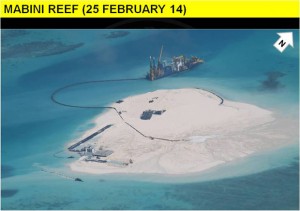
The DFA released photo of the Mabini Reef showing China’s reclamation activities on the disputed area. DFA
MANILA, Philippines — The Philippines and Japan should accept China’s “historical” claim in the South China Sea (West Philippine Sea) instead of complicating the ongoing maritime dispute, an official said Thursday.
“It is our opinion that relevant countries should show sincerity and move towards the same direction with China, rather than deliberately stir up tension and bring additional complicated factors to the regional situation,” Chinese Foreign Ministry Spokesperson Hua Chunying said in a press conference in Beijing Wednesday, the transcript of which was posted online.
“I’d like to point out that China has been long committed to resolving disputes concerning territory and maritime jurisdiction with countries directly concerned through bilateral negotiation and coordination on the basis of respecting historical facts and international laws,” Hua said in response to a question about the recent bilateral talks between Philippine President Benigno Aquino III and Japanese Prime Minister Shinzo Abe in Tokyo.
Aquino and Abe discussed the growing tension between China and both countries over disputed territories in the South China Sea and East China Sea.
Aquino supported Japan’s move to change its constitution to allow for “collective self-defense,” something that China has repeatedly criticized and objected.
China claims nearly the entire South China Sea, including parts of the Philippines 200- nautical mile exclusive economic zone and the Spratly Group of Islands, citing “historical facts.”
The Philippines has challenged China’s “nine-dash line” claim by filing an arbitration case before the International Tribunal on the Law of the Sea (Itlos), saying it has no basis in international law.
China has repeatedly refused to participate in the arbitration case and insisted only on bilateral negotiations, citing its “indisputable sovereignty” over the region.
Supreme Court Associate Justice Antonio Carpio debunked China’s “historical basis” by showing China’s own ancient maps in his series of public lectures.
“There is not a single ancient map, whether made by Chinese or foreigners, showing that the Spratlys and Scarborough Shoal were ever part of Chinese territory,” Carpio said.
“China’s so-called historical facts to justify its nine-dash line are glaringly inconsistent with actual historical facts, based on China’s own historical maps, constitutions and official pronouncements,” he said.
In this Sept. 2012 photo, the tiny islands in the East China Sea, called Senkaku in Japanese and Diaoyu in Chinese are seen. AP FILE PHOTO
Hua accused Japan and the Philippines of threatening the peace and security of the region by encouraging the expansion of Japan’s military.
“We hope that interactions between countries concerned can inject positive energy to the maintaining of regional peace and stability and play a constructive role, not the opposite,” she said.
“Due to historical reasons, China pays close attention to Japan’s policy changes concerning military security which also raise common concern from its Asian neighbors and the international community,” Hua said.